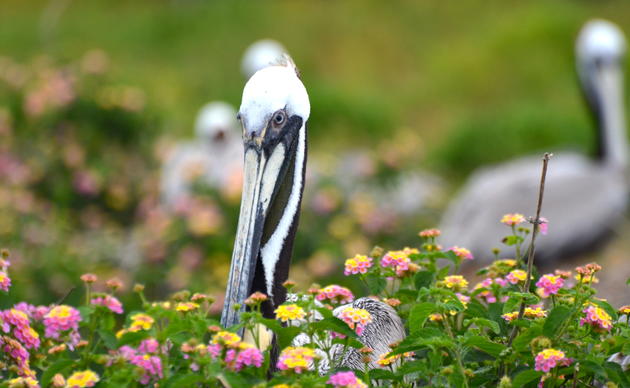Plants & Animals
A Unique Ecosystem
In 1999, on an exploratory hike, amateur naturalist David Hurt discovered a stand of flowering dogwoods (Cornus florida)--a rare and remarkable find, as the flowering dogwood is common to the Pineywoods and post oak belts of East Texas, but is generally absent from shallow clay soils of limestone regions to the West. This was the first of many rare flora and fauna discoveries in the Canyon.
White trout-lily, also called white dog-tooth violet (Erythronium albidum), is a showy spring-blooming forest wildflower that ranges from South Dakota, Ontario and New York south to Georgia and Texas. The population at Dogwood Canyon may be among the largest in this southwestern limit of its range.
Dogwood Canyon also provides the right habitat to support three species of Hexalectris orchids, which are native to the escarpment habitat. Students and faculty from the University of Dallas are studying the ecology and abundance of these unusual flowers. The rare orchids bloom through the summer, and are among only a few hundred in the county. These orchids rely on a relationship with fungi for their nutrition, and grow only in areas with the specific soil types such as those found in the canyon.
Only the oldest Ashe junipers, with their loose, peeling bark, suit the Golden-cheeked Warbler as the right place to build their nests. The ancient junipers in the canyon provide protection and freedom from disturbance that these endangered birds need to rebuild their fragile population. Since the Spanish oak, shin oak and Texas ash are also found here, providing a favorite warbler food (soft-bodied caterpillars), Dogwood Canyon is the perfect habitat for this endangered songbird.
Geology
Dogwood Canyon is a true canyon, located in a particularly hilly part of Dallas County and featuring a 300-foot rise from canyon floor to hilltop. While most of Dallas County lies in the Blackland Prairie, which covered over twelve million acres of Texas from the Red River to San Antonio, Dogwood Canyon is located in an area referred to as the White Rock Escarpment or White Rock Cuesta. The soils and rocks of Dallas County were deposited here when this area was still part of the Great Interior Seaway stretching from the Arctic Circle to the Gulf of Mexico. As the seas departed, they left multiple layers of sediment and rock. Over time, geologic forces tilted the land, exposing these different layers of rock.
You can see the White Rock Escarpment clearly when you travel east toward Dallas along I-20 from Dogwood Canyon. There, the flatter terrain of the Eagle Ford Shale disappears as the white rock of the Austin Chalk deposits appears above ground. Austin Chalk covers approximately one third to one half of Dallas County and is comprised of microscopic skeletons of microorganisms called Coccoliths. The exposure of this geologic formation results in an escarpment that rises 200 feet from the creek bottoms near Joe Pool Lake to an elevation of as much as 820 feet in Cedar Hill. At one time, these hills were covered with grasses, but over time, as fires decreased, the area reached a climax plant community dominated by oaks and Ashe junipers.
How you can help, right now
Join Audubon Texas Today
Becoming a member supports our local work protecting birds and the places they need.
Consider a Legacy Gift for Texas
Planned gifts and bequests allow you to provide a lasting form of support to Audubon Texas.
Subscribe to Our Newsletter
Subscribe to our newsletter for updates about Audubon Texas's conservation work, and news about our activities and local events.




